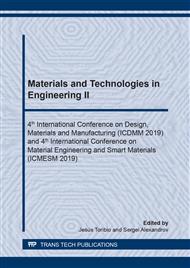p.50
p.55
p.61
p.71
p.78
p.86
p.93
p.102
p.109
Tensile and Compressive Creep Behavior of IN718 Alloy Manufactured by Selective Laser Melting
Abstract:
Tensile and compressive creep behavior of SLMed IN718 alloy under 973K (700°C) were investigated. Crept samples were analyzed by SEM and TEM to expose evolution of microstructure, precipitates and dislocation structure during the creep process. Results show that initial creep rate under compression is higher than under tension for the same creep conditions. Minimum creep rates are approximately the same both in tensile and compressive creep tests. The different creep behaviors may be related to the fact that tension stress promotes precipitations of fine needle-like γ′′ phases, while compression stress promotes precipitations of large size δ phases. The tension-compression asymmetry owns to the increment of chemical potential varying with the stress orientation.
Info:
Periodical:
Pages:
102-108
Citation:
Online since:
April 2020
Authors:
Keywords:
Price:
Сopyright:
© 2020 Trans Tech Publications Ltd. All Rights Reserved
Share:
Citation:


